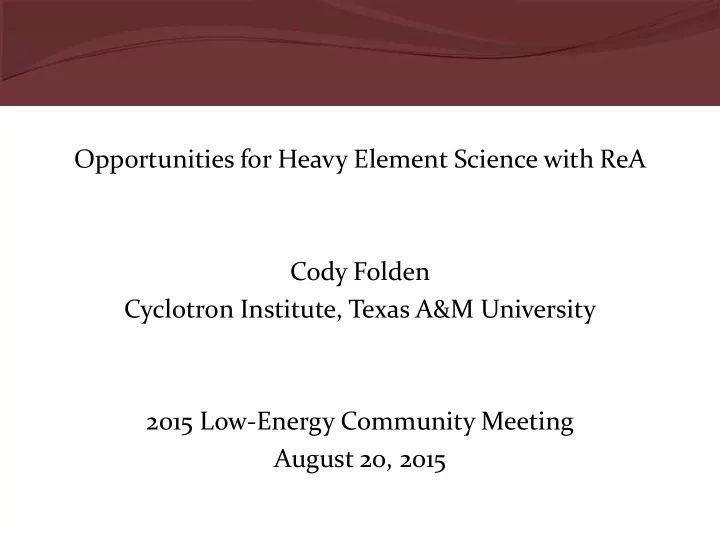

Opportunities for Heavy Element Science with ReA Cody Folden Cyclotron Institute, Texas A&M University 2015 Low-Energy Community Meeting August 20, 2015
How does the nuclear reaction work? s cap P CN Overall, a fusion reaction is described by: s = s cap P CN W sur W sur
How do you make a heavy nucleus? The production of a heavy nucleus is a competition between neutron emission and fission. The evaporation residue cross section can be written as: Fission * E s s 1 S P W ( *, ) E l , 1 n cap CN sur E Fission n , 1 * E x 2 S , 2 n s P / E cap CN n tot i , 2 Fission n * E 3 1 i S , 3 n E x , 3 n s S P / , 4 n cap CN n f i E , 4 n 1 i / exp[ ( S B )/ T ] n f n f
The Challenge of Heavy Element Experiments with RIBs Today When producing heavy nuclei, the available beam intensities are modest:’ s cap ~ 150 mb, N t = 500 µg/cm 2 248 Cm, I = 7 10 4 s – 1 39 Ar R = s N t I = . . . = 1.3 10 – 2 s – 1 ~ 1.1 10 3 d – 1 For now, experiments are limited by production rates. This limits the experiments that can be done and increases their difficulty as well.
Capture/Fusion Cross Sections with Neutron-Rich Beams There is some evidence that fusion is more likely with neutron-rich beams. J. F. Liang et al ., PRL 96 , 029903 (2006). W. Loveland et al ., PRC 74 , 044607 (2006).
Coincident Fission Fragment Detector CFFD • Four Parallel Plate Avalanche Counters (30cm x 40cm) • MCP for ns scale start signal. • Portable measurements at other facilities. • Digital Data Acquisition • Fusion measurements to investigate P CN and σ capture with n-rich and p-rich RIBs at ReA3. • Flexibility of CFFD allows several different detector configurations. • Future: FRIB will provide intensities to continue heavy-ion fusion studies but open opportunities to look at ER cross sections. A. Wakhle, 8/24/2015, Slide 9
The Problem with P CN Difficult to measure. Data have large uncertainty. Theory has large uncertainty. R. Yanez et al ., PRC 88 , 014606 (2013). K. Siwek- Wilczyńska et al. , IJMPE 17 , 12 (2008).
Projectiles with Z 20 Reacting with Lanthanide Targets MOTIVATION: Prospects of SHE Synthesis with Z p > 20 Rxns. Studied: 44 Ca CN 50 Ti CN 48 Ca CN 54 Cr CN 45 Sc CN
Dependence of B f – S n on Model The model used has a dramatic impact on B f – S n . This likely has a dramatic impact on the cross section. K. Siwek- Wilczyńska et al. , Int. J. Mod. Phys. E 18 , 1079 (2009).
The Situation with Fission Barriers Calculations are available, but experimental data are hard to come by. X. J. Bao et al . PRC 92 , 014601 (2015). G. N. Smirenkin, IAEA-Report INDC(CCP)-359 (1993).
Influence of Angular Momentum The question of angular momentum and its influence on compound nuclei is complex. Several groups have suggested that angular momentum needs to be reduced to realistically represent what actually contributes to the cross section. G. Henning et al ., Phys. Rev. Lett. 113 , 262505 (2014). See also A. N. Andreyev et al ., Phys. Rev. C 72 , 014612 (2005).
Measurement of n / tot 26 Mg + 248 Cm: 25 Mg + 248 Cm: Some clever math shows that Neutron-deficient radioactive beams could expand these The first-chance survival studies. probability was (89 ± 13)%. Surprisingly high! R. Yanez et al. , Phys. Rev. Lett. 112 , 152702 (2014).
Takeaway Messages Reaccelerated radioactive beams near he Coulomb barrier can contribute to understanding all three phases of heavy element formation: Measurements of s cap to understand whether neutron- rich nuclei have increased fusion probabilities. Measurements of P CN to help reduce experimental and theoretical uncertainties. Measurements of fission barriers and survival probabilities, which affect the most important component of the cross section. All of this should go hand-in-hand with a vigorous theory program.
Acknowledgements: Coworkers Folden Group Members: M. C. Alfonso E. R. Bertelsen T. K. Bhardwaj M. E. Bennett M. J. DeVanzo L. D. Fields M. M. Frey D. A. Mayorov J. A. Sefcik M. F. Volia T. A. Werke
Acknowledgements DOE K. Siwek- Wilczyńska and A. V. Karpov for DE-FG02-93ER40773 informative discussions. DE-FG07-05ID14692/MUSC09-100 Cyclotron Institute staff. DE-FG02-12ER41869/DE-SC0008126 Welch Foundation: A-1710 NSF: PHY-1004780
Recommend
More recommend